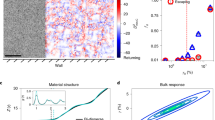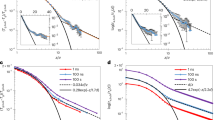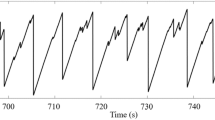Abstract
The interaction between an imposed shear flow and an order–disorder transition underlies a broad range of phenomena. Under the influence of shear flow, a variety of soft matter1,2,3,4 is observed to spontaneously form bands characterized by different local order—for example, thermotropic liquid crystals subjected to shear flow exhibit rich phase behaviour5. The stability of order under the influence of shear flow is also fundamental to understanding frictional wear6 and lubrication7,8. Although there exists a well developed theoretical approach to the influence of shear flow on continuous transitions in fluid mixtures9, little is known about the underlying principles governing non-equilibrium coexistence between phases of different symmetry. Here we show, using non-equilibrium molecular dynamics simulations of a system of spherical particles, that a stationary coexistence exists between a strained crystal and the shearing liquid, and that this coexistence cannot be accounted for by invoking a non-equilibrium analogue of the chemical potential. Instead of such thermodynamic arguments10,11, we argue that a balancing of the crystal growth rate with the rate of surface erosion by the shearing melt can account for the observed coexistence.
This is a preview of subscription content, access via your institution
Access options
Subscribe to this journal
Receive 51 print issues and online access
$199.00 per year
only $3.90 per issue
Buy this article
- Purchase on Springer Link
- Instant access to full article PDF
Prices may be subject to local taxes which are calculated during checkout




Similar content being viewed by others
References
Berret, J., Roux, D. & Porte, G. Inhomogeneous shear flows of wormlike micelles: A master dynamic phase diagram. Phys. Rev. E 55, 1668–1676 (1997).
Eiser, E., Molino, F., Porte, G. & Diat, O. Nonhomogeneous textures and banded flow in a soft cubic phase under shear. Phys. Rev. E 61, 6759–6764 (2000).
Chen, L., Chow, M., Ackerson, B. & Zukoski, C. Rheological and microstructural transitions in colloidal crystals. Langmuir 10, 2817–2829 (1994).
Fischer, E. & Callaghan, P. T. Shear banding and the isotropic-nematic transition in wormlike micelles. Phys. Rev. E 64, 011501–011516 (2001).
Tsuji, T. & Rey, A. The effect of long range order on sheared liquid crystalline materials. Phys. Rev. E 62, 8141–8151 (2000).
Sasada, T. & Mishina, H. Freezing point depression within a shear field, with special reference to metallurgical transformations occurring during wear. Wear 74, 263–274 (1981).
Thompson, P. A. & Robbins, M. O. Origin of stick-slip motion in boundary lubrication. Science 250, 792–794 (1990).
Bordarier, P., Schoen, M. & Fuchs, A. Stick-slip phase transitions in confined solid-like films from an equilibrium perspective. Phys. Rev. E 57, 1621–1635 (1998).
Onuki, A. Phase transitions of fluids in shear flow. J. Phys. Condens. Matter 9, 6119–6157 (1997).
Ramaswamy, S. & Renn, S. Theory of shear-induced melting of colloidal crystals. Phys. Rev. Lett. 56, 945–948 (1986).
Baranyai, A. & Cummings, P. Towards a computational chemical potential for nonequilibrium steady-state systems. Phys. Rev. E 60, 5522–5527 (1999).
Ackerson, B. J. & Clarke, N. A. Shear-induced partial translational ordering of a colloidal solid. Phys. Rev. A 30, 906–918 (1984).
Stevens, M. & Robbins, M. Simulations of shear-induced melting and ordering. Phys. Rev. E 48, 3778–3792 (1993).
Butler, S. & Harrowell, P. The shear induced disordering transition in colloidal crystals: Nonequilibrium Brownian dynamics simulations. J. Chem. Phys. 103, 4653–4671 (1995).
Goveas, J. & Pines, D. J. A phenomenological model of shear-thickening in wormlike micelle solutions. Europhys. Lett. 48, 706–712 (1999).
Ajdari, A. Rheological behaviour of a solution of particles aggregating on the containing walls. Phys. Rev. E 58, 6294–6298 (1998).
Olmsted, P. & Lu, C.-Y. D. Phase separation of rigid-rod suspensions in shear flow. Phys. Rev. E 60, 4397–4415 (1999).
Allen, M. & Tildesley, D. Computer Simulations of Liquids (Clarendon, Oxford, 1990).
Stevens, M. et al. Comparison of shear flow hexadecane in a confined geometry and in bulk. J. Chem. Phys. 106, 7303–7314 (1997).
Acknowledgements
This work was supported by an Institutional Grant from the Australian Research Council.
Author information
Authors and Affiliations
Corresponding author
Rights and permissions
About this article
Cite this article
Butler, S., Harrowell, P. Factors determining crystal–liquid coexistence under shear. Nature 415, 1008–1011 (2002). https://doi.org/10.1038/4151008a
Received:
Accepted:
Issue Date:
DOI: https://doi.org/10.1038/4151008a
This article is cited by
-
Contributions of Molecular Dynamics Simulations to Elastohydrodynamic Lubrication
Tribology Letters (2021)
-
Advances in nonequilibrium molecular dynamics simulations of lubricants and additives
Friction (2018)
-
The role of shear in crystallization kinetics: From suppression to enhancement
Scientific Reports (2015)
-
Anisotropic mechanical amorphization drives wear in diamond
Nature Materials (2011)
-
Gradient and vorticity banding
Rheologica Acta (2008)
Comments
By submitting a comment you agree to abide by our Terms and Community Guidelines. If you find something abusive or that does not comply with our terms or guidelines please flag it as inappropriate.



